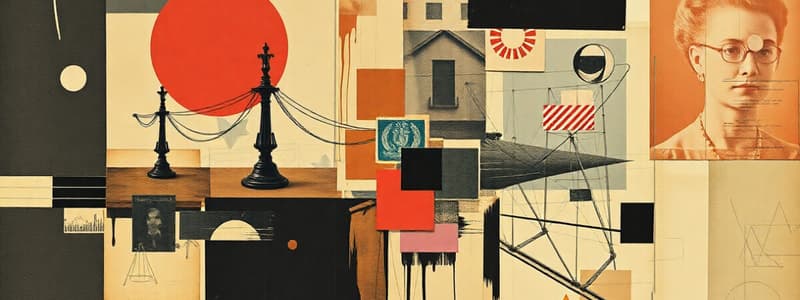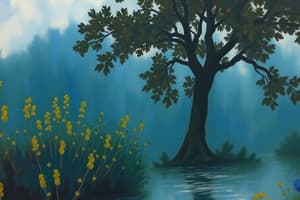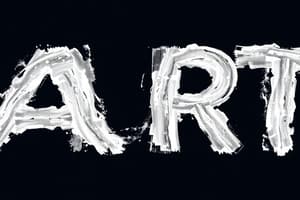Podcast
Questions and Answers
What role does line play in a work of art?
What role does line play in a work of art?
- It enhances the tactile quality of artwork.
- It adds depth and realism by representing three-dimensional objects.
- It gives structure and guides the viewer's eye. (correct)
- It provides the basic forms that make up a composition.
Which element of art is primarily responsible for creating mood and expressing emotions?
Which element of art is primarily responsible for creating mood and expressing emotions?
- Color (correct)
- Shape
- Value
- Line
How does space contribute to a work of art?
How does space contribute to a work of art?
- It determines relationships between objects and creates depth. (correct)
- It contrasts between light and dark areas.
- It provides the basic forms of the composition.
- It organizes elements and creates patterns.
What is the primary purpose of texture in art?
What is the primary purpose of texture in art?
Which of the following best describes the concept of transcreation in arts?
Which of the following best describes the concept of transcreation in arts?
What significant influence did Japanese woodblock prints have on Vincent Van Gogh?
What significant influence did Japanese woodblock prints have on Vincent Van Gogh?
What does value in art primarily refer to?
What does value in art primarily refer to?
Which aspect of form enhances the realism in artwork?
Which aspect of form enhances the realism in artwork?
How do artists worldwide adapt their expressive forms and themes?
How do artists worldwide adapt their expressive forms and themes?
What type of balance is demonstrated in 'The Starry Night' by Vincent Van Gogh?
What type of balance is demonstrated in 'The Starry Night' by Vincent Van Gogh?
Which element primarily draws attention in 'The Persistence of Memory' by Salvador Dalí?
Which element primarily draws attention in 'The Persistence of Memory' by Salvador Dalí?
How does 'Composition VIII' by Wassily Kandinsky create visual interest?
How does 'Composition VIII' by Wassily Kandinsky create visual interest?
What does proportion refer to in art compositions?
What does proportion refer to in art compositions?
Which artwork features a rhythmic pattern through the arrangement of elements?
Which artwork features a rhythmic pattern through the arrangement of elements?
What does the element of variety achieve in artwork?
What does the element of variety achieve in artwork?
Which artwork illustrates the concept of ideal human proportions?
Which artwork illustrates the concept of ideal human proportions?
What defines asymmetrical balance in a composition?
What defines asymmetrical balance in a composition?
In what way can contrast enhance an artwork?
In what way can contrast enhance an artwork?
What element is important for achieving unity in an artwork?
What element is important for achieving unity in an artwork?
Which artistic approach emphasizes the transformation of an artwork's medium or context?
Which artistic approach emphasizes the transformation of an artwork's medium or context?
What does the principle of unity in art refer to?
What does the principle of unity in art refer to?
In what way did Van Gogh reinterpret Hiroshige's 'Bridge in the Rain'?
In what way did Van Gogh reinterpret Hiroshige's 'Bridge in the Rain'?
Which term describes the use of elements from an existing artwork to create something new?
Which term describes the use of elements from an existing artwork to create something new?
What does distortion in transcreation focus on?
What does distortion in transcreation focus on?
How does Van Gogh's adaptation of 'The Courtesan' differ from Eisen's original work?
How does Van Gogh's adaptation of 'The Courtesan' differ from Eisen's original work?
Which artist's work inspired Aristide Maillol’s piece 'La Nuit'?
Which artist's work inspired Aristide Maillol’s piece 'La Nuit'?
What emotional quality does Van Gogh's 'Bridge in the Rain' convey through its transformation?
What emotional quality does Van Gogh's 'Bridge in the Rain' convey through its transformation?
Which principle of art acts to enhance the impact and aesthetic quality of a piece?
Which principle of art acts to enhance the impact and aesthetic quality of a piece?
What is an example of transformation in artwork?
What is an example of transformation in artwork?
What does the Rule of Thirds primarily focus on in composition?
What does the Rule of Thirds primarily focus on in composition?
In terms of focal points, how should they be used according to the Rule of Thirds?
In terms of focal points, how should they be used according to the Rule of Thirds?
Which of the following elements is NOT commonly used in compositions employing the Rule of Thirds?
Which of the following elements is NOT commonly used in compositions employing the Rule of Thirds?
In Samuel Peploe's still life painting, what is aligned with the bottom third of the image?
In Samuel Peploe's still life painting, what is aligned with the bottom third of the image?
What describes the overlapping areas of the circles in the Rule of Thirds?
What describes the overlapping areas of the circles in the Rule of Thirds?
How is light utilized in the painting Still Life with Coffee Pot?
How is light utilized in the painting Still Life with Coffee Pot?
Why is the Rule of Thirds significant in art composition?
Why is the Rule of Thirds significant in art composition?
Which of the following artworks is mentioned as using the Rule of Thirds?
Which of the following artworks is mentioned as using the Rule of Thirds?
What is the primary purpose of focal points in compositions using the Rule of Thirds?
What is the primary purpose of focal points in compositions using the Rule of Thirds?
What is a common mistake when applying the Rule of Thirds?
What is a common mistake when applying the Rule of Thirds?
Flashcards are hidden until you start studying
Study Notes
Elements of Art
- The elements of art are the building blocks artists use to create artwork.
- Line: Provides structure, shape, guides the viewer's eye, and conveys emotion or movement.
- Shape: Provides basic forms, organizes elements, and creates patterns.
- Color: Evokes mood, expresses emotions, creates visual interest, conveys symbolism, and highlights focal points.
- Space: Determines relationships between objects, creates depth, perspective, and openness or confinement.
- Texture: Enhances tactile quality, makes artwork interesting visually and physically, indicating how surfaces feel.
- Value: Creates contrast between light and dark areas, creates depth, emphasizes shapes, and gives objects solidity.
- Form: Adds depth and realism to artwork by representing three-dimensional objects and showing volume.
Transcreation in Arts
- Transcreation involves reinterpreting or adapting creative works to fit new cultural contexts.
- It preserves the essence and purpose of the original work.
- It involves creative adaptation and cultural sensitivity to maintain the original artistic vision.
- Examples:
- Vincent van Gogh's "The Courtesan (after Eisen)" was inspired by Keisai Eisen's Japanese woodblock prints, showcasing his fascination with Japanese art and contemporary images.
- "Bridge in the Rain (after Hiroshige)" by Vincent van Gogh is a direct interpretation of a Japanese print by Utagawa Hiroshige.
- Auguste Rodin's "The Thinker" has heavily influenced modern sculpture, with artists adapting its themes and forms to address contemporary issues.
Factors Influencing Transcreation
- Distortion: Changing characteristics of the original artwork like shape, color, or form.
- Example: Van Gogh's "Bridge in the Rain (after Hiroshige)" reinterprets Hiroshige's print with unique colors, shapes, and brushstrokes.
- Transformation: Changing the medium or context of the original work.
- Example: "The Persistence of Memory" by Salvador Dalí adapted into a 3D digital model changes the way it can be experienced.
- Appropriation: Using elements from an existing work to create something new.
- Example: Van Gogh's "The Courtesan (after Eisen)" reinterprets a Japanese woodblock print in his unique style while keeping the main subject and composition.
Principles of Art
- Principles of art are guidelines for organizing elements within artwork.
- They create a coherent whole, guide the viewer's attention, and enhance the aesthetic quality of piece.
- Unity: Ensures all elements work harmoniously to create a cohesive whole.
- Example: "The Birth of Venus" by Sandro Botticelli creates unity through the harmonious arrangement of figures, colors, and composition.
- Balance: Refers to the distribution of visual weight in a composition.
- Symmetrical: Equal weight on both sides of a central axis.
- Asymmetrical: Unequal balance creating harmony.
- Radial: Balance around a central point.
- Example: "The Starry Night" by Vincent van Gogh demonstrates asymmetrical balance with the swirling sky balanced by the village and cypress tree.
- Emphasis: Refers to the focal point that stands out and attracts attention.
- Example: "The Persistence of Memory" by Salvador Dalí highlights the melting clocks as the focal point.
- Contrast: Noticeable difference between elements enhancing their strengths and creating interest.
- Example: "Composition VIII" by Wassily Kandinsky uses contrasting colors, shapes, and sizes.
- Proportion: Size relationships between elements in a composition, maintaining harmony and scale.
- Example: "Vitruvian Man" by Leonardo da Vinci illustrates the ideal human proportions based on Vitruvius' writings.
- Pattern: Arrangement of alternated or repeated elements like shapes, lines, colors, or motifs.
- Example: "The Great Wave Off Kanagawa" by Katsushika Hokusai features dynamic, stylized waves creating a rhythmic pattern.
- Variety: Use of several design elements to hold the viewer's attention and guide their eye through the artwork.
- Example: "Campbell's Soup Cans" by Andy Warhol uses repetition of the cans with variations in colors and arrangements.
The Rule of Thirds
- Divides an image into thirds horizontally and vertically.
- Focal points are the overlapping areas of the red circles, drawing the viewer's attention.
- Artists often use horizontal lines to separate foreground and background content.
- Example: "Still Life with Coffee Pot" by Samuel Peploe uses the Rule of Thirds with the table edge on the bottom third, the teapot's reflection two-thirds across the frame, and the orange and lemon at one of the focal points.
Studying That Suits You
Use AI to generate personalized quizzes and flashcards to suit your learning preferences.



